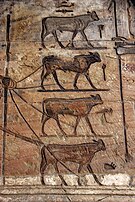This is an old revision of this page, as edited by Kgriffisgreenberg (talk | contribs) at 15:19, 11 June 2009. The present address (URL) is a permanent link to this revision, which may differ significantly from the current revision.
Revision as of 15:19, 11 June 2009 by Kgriffisgreenberg (talk | contribs)(diff) ← Previous revision | Latest revision (diff) | Newer revision → (diff)| This article is an orphan, as no other articles link to it. Please introduce links to this page from related articles; try the Find link tool for suggestions. (August 2008) |
| ||
| a piece of crocodile skin with spines in hieroglyphs | ||
|---|---|---|
The Ancient Egyptian Black (hieroglyph), has different forms, but with similar meanings related to the common color black; it has other meanings, elsewhere used by various addititive determinatives.
Ancient Egypt is commonly referred to as 'km.t' , with the theorized reference to the black Nile Delta earth. The determinative O49 is used to designate the term for 'country, inhabited land', called the niw.t (a political designate). It is a circle with a cross which represents a city intersection.
Other word uses of "black" are also related to the, gloomy, or dark.
Hieroglyphic definition of glyph-icon
The hieroglyph I6 is commonly explained as a piece of crocodile skin with spines (Gardiner 2005 (1957): 475).
Rosetta Stone: hieroglyph and Demotic "kmi"-"Egypt"

identified as "black".
The 198 BC Rosetta Stone uses the Black (hieroglyph) three times to make the name of Egypt: Kam-t, or Kem-t. Of the 21 uses, 6 are for another name of Egypt as iAt.
In the Demotic (Egyptian) text of the Rosetta Stone, the demotic for Egypt is 'Kmi' . There are three uses of the actual Kmi, but 6 others referenced as Kmi refer to iAt in the hieroglyphs.
- Kmi—spelling-Egypt—(21 places, sychronized, Demotic–Hieroglyphs)
|
Literature
A magazine focussed on Ancient Egypt, its history, its iconography, and its modern day archaeological or linguistic work, is named for the name Kam-t-(Egypt). See Kmt (journal).
-
 A cow
A cow
identified as "black" -
 Nectanebo II obelisk, with various hieroglyphs including statement of erecting the obelisk-(to set-up: the Mast hieroglyph). (photo can be high-res expanded)
Nectanebo II obelisk, with various hieroglyphs including statement of erecting the obelisk-(to set-up: the Mast hieroglyph). (photo can be high-res expanded)
See also
- Kmt (journal)
- Kemeticism
- Kemet
- Mnewer, the black bull: "Black-Great (One)", Kem-wer (km-wr)
External links
References
- Erman, A. and H. Grapow 1926. Wörterbuch der Aegyptischen Sprache. (7 Vols.) Leipzig: J. C. Hinrich.
- Gardiner, A. H. 2005 (1957). Egyptian Grammar: Being an Introduction to the Study of Hieroglyphs. Oxford: Griffith Institute.
- Hannig, R. 1995. Die Sprache der Pharaonen: Großes Handwörterbuch Ägyptisch-Deutsch (2800 - 950 v. Chr.). Kulturegeschichte der Antiken Welt 64. Mainz: von Zabern.
- Wilson, P. 1997. A Ptolemaic Lexikon. A Lexographical Study of the Texts of the Temple of Edfu. Orientalia Lovaniensia Analecta 78. Leuven: Peeters/Department of Oosterse Studies.